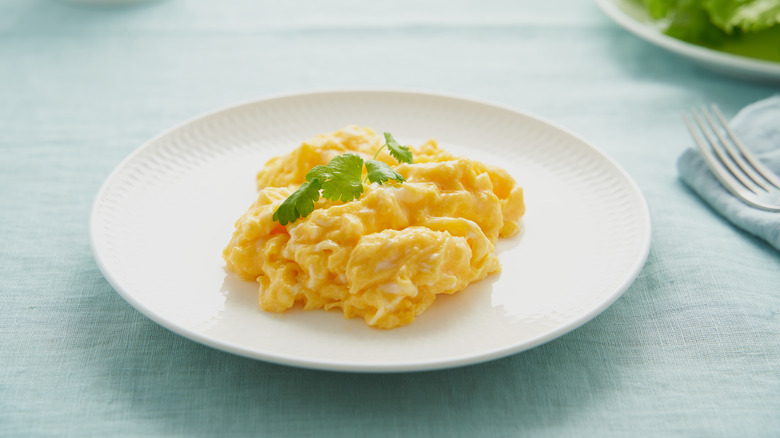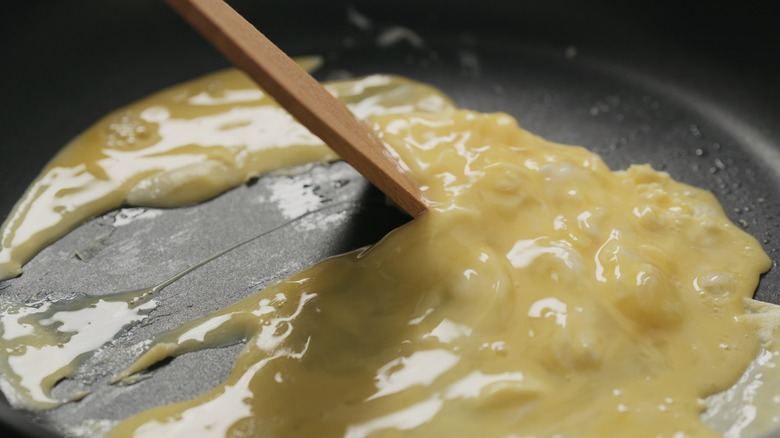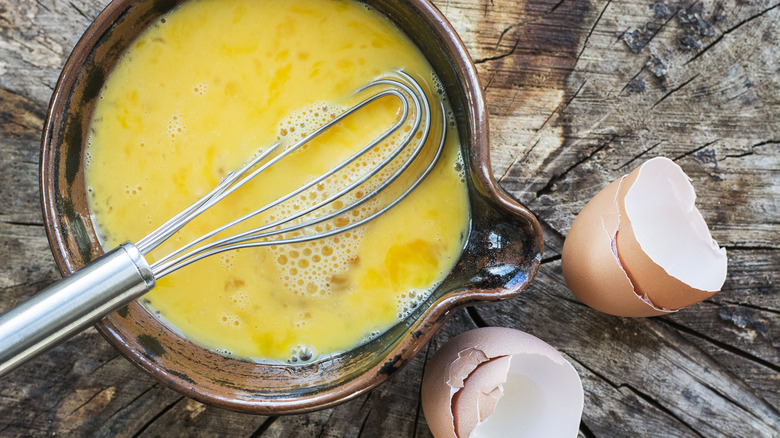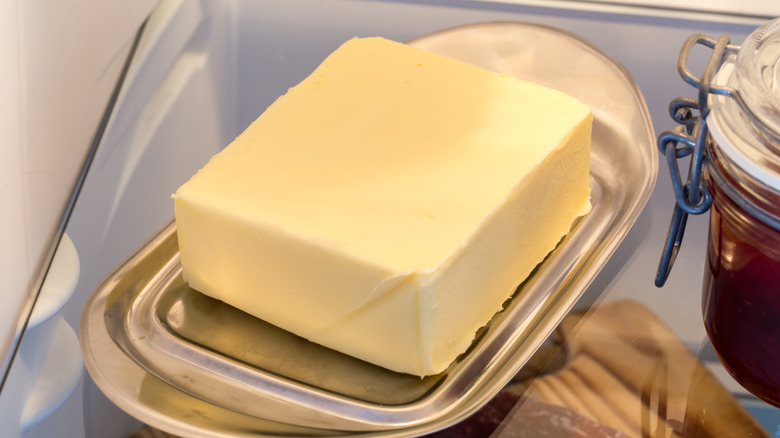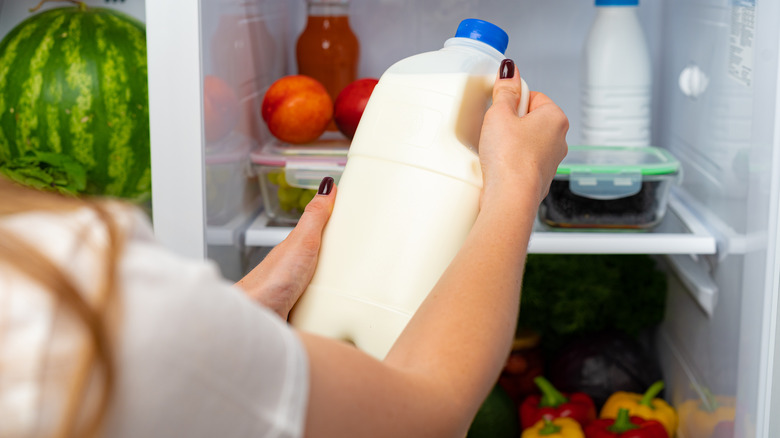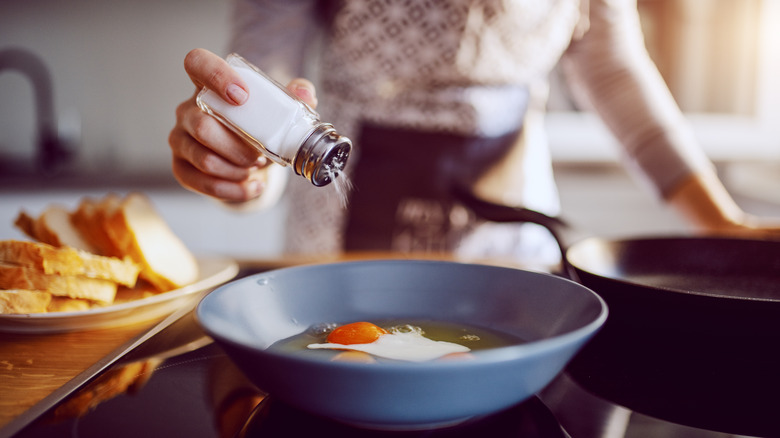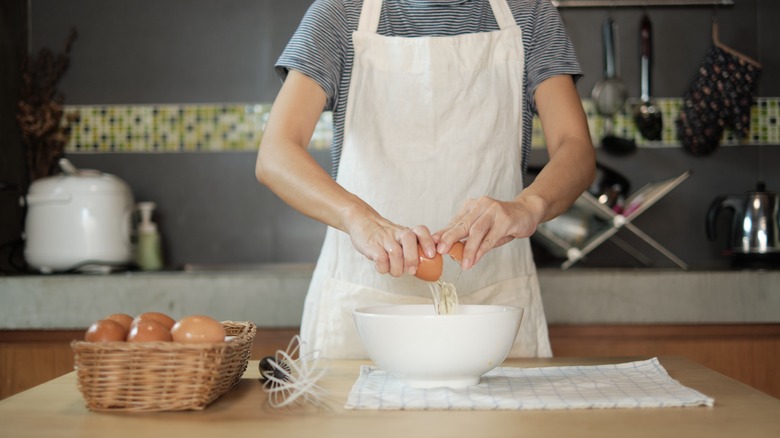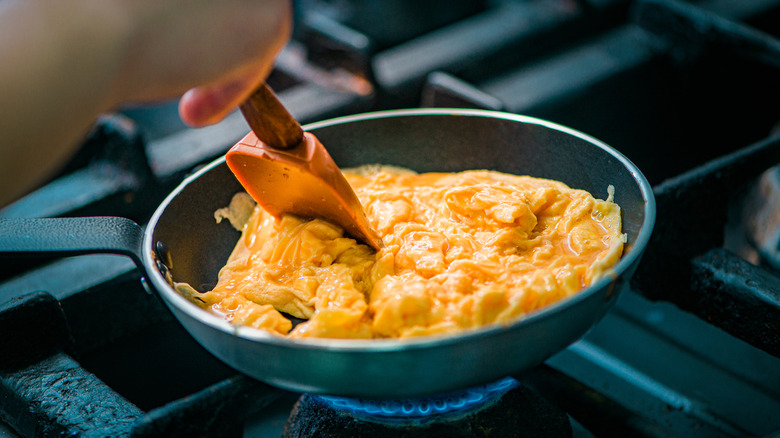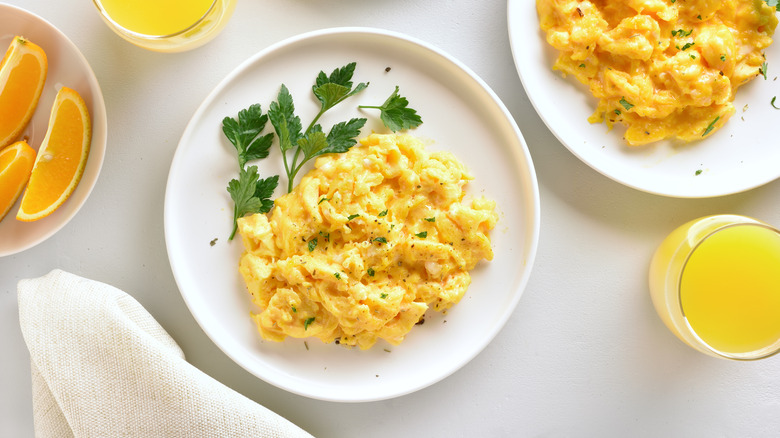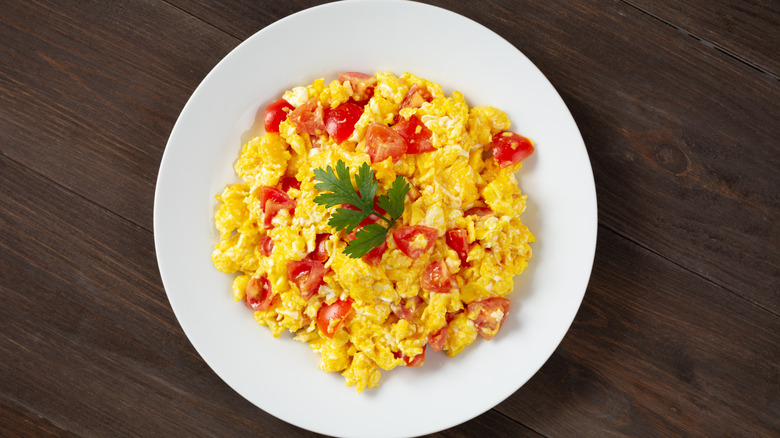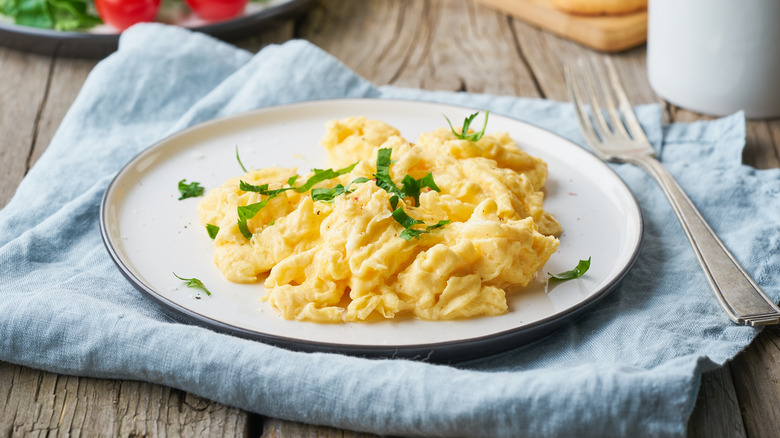What Everyone Forgets When Cooking Scrambled Eggs
You'll find eggs making an appearance at nearly every breakfast spread. Some credit their popularity at breakfast — alongside bacon and toast — to a savvy marketing ploy to sell more bacon, where an advertiser convinced doctors in the 1920s to publicly give their support for eating eggs and bacon at the start of the day. Others say the connection is much more simple: Chickens often lay their eggs in the morning, farmers and laborers need a quick, cheap but filling breakfast, so they're an obvious option (via Sauder's Eggs).
However they became a crucial part of breakfast, there are innumerable essential ways to cook eggs. Arguably the easiest way is by scrambling them. There's no need to time the boil or flip. There are no worries about getting the yolk set just right. Scrambling eggs is easy ... right? Well, while scrambling eggs is easy, that doesn't mean there aren't pitfalls you can fall prey to while cooking your breakfast (or lunch or dinner, they work anytime). Here are a few things everyone forgets when cooking scrambled eggs, and the easy ways to make sure you turn out a perfect dish every time.
A nonstick pan is crucial
Don't just grab any pan or skillet from the pantry when it's time to scramble eggs. When Saveur spoke with a handful of chefs to glean their insight on egg cooking, the majority said nonstick pans are the way to go when you're cooking scrambled eggs. You'll want a pan that has a lightweight feel, even heat distribution, and of course, one that's easy to clean.
Whichever nonstick pan you pick up for your next breakfast, though, there are a few things to remember to get the best cooking experience (via Food Network). First, never use your nonstick pan over high heat. The high heat of your dishwasher can also damage the pan (even if the maker claims the pan is dishwasher-safe). To further protect your nonstick pan from damage, don't spray it with nonstick aerosol sprays and don't use metal tools to scoot your scrambled eggs around. All of the above can compromise your nonstick pan's quality, leading to sticking that renders the pan useless.
Mix the eggs the right way
If you're busy trying to get breakfast on the table and your family out the door, you might be tempted to take as many shortcuts as possible. When it comes to eggs, you'll likely crack them on the side of the pan, throw them in, run a fork over them a few times as they start to cook, and hope no one will be able to tell the difference.
But hold up. Just an extra step or two can take your scrambled eggs to the next level. The key to achieving a perfectly soft and fluffy texture is air, according to Lifehacker. You want to get as much air into your egg mixture before the cooking process begins. One easy way to do this is by using your immersion blender (this is just one of the many great uses for an immersion blender). With no hard work on your end, the blender adds a significant amount of air to your mixture. If you don't have an immersion blender, go at your eggs with a metal whisk. You'll get a similar effect, but it'll just take a little longer, and require a little more effort on your part.
Use whatever fat you have on hand
Some people swear by butter to make scrambled eggs, while others sing the praises of olive oil, or ghee. The truth is, though, you don't need to hold off on making your scrambled eggs just because you don't have the right fat on hand. You can scramble them using whatever is in your pantry. It's worth noting, though, that whichever fat you use will impact the end result.
As Martha Stewart explains, butter results in soft scrambled eggs. Clarifying butter before cooking can also enhance the taste (or you can buy ghee from the grocery store). If you use butter, just be sure that it's unsalted, so you don't end up oversalting your eggs as you add your seasonings.
GBH, though, says olive oil can give a "velvety texture and richer flavor." If you decide to use this simple trick to take your scrambled eggs to the next level, consider adding the olive oil to your egg mixture in place of dairy, before scrambling, for a similar texture without the dairy.
Use whatever liquid you have on hand
Basically everyone would agree the key components needed for scrambled eggs include the eggs, plus a fat for cooking. For some people, that's enough, but others like to add in an extra liquid, too. Some use milk or cream, while others swear by mayonnaise. If you're all out, just add a little tap water before cooking. You might actually find you prefer it. One unexpected hack for perfectly fluffy scrambled eggs is cooking them in a few inches of water.
The reason you should try adding water to your scrambled eggs is that water creates a fluffier texture than you might be able to achieve with just milk. While Real Simple admits that, if you're accustomed to using milk or cream, you might find the flavor is slightly dulled, you can remedy that by adding a little cheese or crème fraîche after the eggs are cooked.
Whatever liquid you add, just be sure to watch your cooking process carefully, as any added liquid can increase the cooking speed, making it all too easy to overcook or burn your scrambled eggs. This is why you should think twice about putting milk or any liquid in your eggs if you're not willing to keep a close eye on them.
Add salt ahead of time
Don't let seasoning your scrambled eggs become an afterthought. When and how you choose to season them will greatly impact your end result, as James Beard award-winning chef Ashley Christensen told Williams-Sonoma.
Christensen recommends a tip she picked up from J. Kenji López-Alt at The Food Lab. After you beat, whisk, or immersion blend your eggs, you should add salt about 15 minutes before you add them to the pan. Not only does this guarantee the salt works its way through all your mixture, making sure every fluffy morsel is perfectly seasoned, but adding salt just ahead of cooking can make for runny eggs.
The reason why 15 minutes prior to cooking is the best time to salt scrambled eggs all comes down to science. Salt changes the chemical makeup of eggs, influencing how the proteins bind together and react to heat, giving you a better egg texture when you have a little patience (via My Recipes).
Don't crack the egg against the pan
You're busy. You don't have time to do anything fancy. You just want to get your eggs scrambled and done. So, you crack it against the nearest hard surface: the side of your nonstick frying pan. However, there are some pretty good reasons why you shouldn't do this.
As HuffPost explains, cracking on the edge of a pan pushes the eggshell back against the egg itself and into the liquid — which means it's far more likely you'll end up with broken eggshells in whatever you're making. Not only are eggshells unpleasant to eat, but they're also home to salmonella (via the Centers for Disease Control and Prevention).
Since no one likes fishing pieces of shell out of their food and no one likes food poisoning, go with the preferred countertop method. Tap your egg a few times on the surface and then deposit in your pan. If you've been cracking your eggs on the pan, don't be embarrassed, though: HuffPost conducted a survey and found that nearly 60% of Americans crack their eggs that way.
The heat determines how your eggs will end up
Think you're in the clear once you have your eggs mixed and in the pan? Think again. The level of heat you use to cook will greatly determine the texture. While you should generally use medium heat if you're scrambling eggs in a nonstick pan, there's a big difference between cooking on low heat and medium-high heat, according to Egg Farmers of Canada.
Cooking your eggs on medium-high heat typically results in a hard scramble, aka firmer and drier eggs that can hold up to heavier add-ins without falling apart (think salsa or chopped veggies). Cooking on medium-high heat is also, obviously, quicker.
Cooking on medium-low heat, however, usually results in softer, fluffier, creamier eggs, also known as a soft scramble. Because of their richer, yet delicate texture, these eggs are often best enjoyed on their own or in a dish where they won't get squished, like an open-faced breakfast sandwich.
Eggs continue cooking when they're taken off the heat
When cooking a steak and looking at its doneness and temperature, you might have heard the term "carryover cooking." This is when the internal temperature continues to rise even once you've taken it off the heat source, meaning you need to strategize accordingly. The exact same thing happens when you're cooking scrambled eggs as well.
As MyRecipes explains, if you cook your eggs until they're perfectly done, you may end up with a drier result than you want. The leftover heat from the cooking process will continue impacting your eggs for a few minutes, but a few minutes is a long time when scrambling eggs. To get the perfect texture, cook your eggs until they're nearly as done as you like them. Then, remove them from the heat. You'll find that, once you're at the breakfast table, the eggs are the perfect consistency. This is Jamie Oliver's simple tip for perfectly cooked scrambled eggs, too.
Extra ingredients go a long way
If you're growing a bit bored of your standard scrambled eggs — even if you've perfected them with all the right cooking methods — then you might want to consider throwing in a few delicious extra ingredients. We're not talking about a handful of cheddar cheese or a little Tabasco, though.
Food professionals told Insider the secret ingredients they use in scrambled eggs. Chef Nick Leahy likes to add pesto to his scrambled eggs right as they finish cooking. He's not the only one, as pesto eggs went viral on TikTok in 2021. Chef Trevor Teich adds sherry vinegar to his scrambled eggs, before cooking, while Leahy likewise sometimes substitutes yogurt for other dairy, like milk or cream, in his egg mixture. Have some stale chips or hot dogs hanging around that need using up? Those are two other interesting additions chefs recommended for a new take on scrambled eggs.
There's no wrong way to cook scrambled eggs
There are many different ways to scramble eggs. An Insider taste test tried 10 of the many options, noting the differences. Using melted butter and a medium heat creates a drier, browner egg, while low heat produces a creamier result. Not whisking the egg before adding it to the pan makes for bigger chunks of separated white and yolk, and using heavy cream makes for a fluffier yet more dense egg.
However, no matter how you scramble your egg, a good egg is a good egg. Sure, you could burn them or accidentally end up with a lot of eggshell in your mixture, but otherwise, there aren't really any incorrect ways to scramble an egg. There are tons of different ways to go about it — butter or oil, water or milk, high or low heat — with all the options resulting in different textures and tastes that will be appealing to someone out there. You just need to find how you like your scrambled eggs best.
